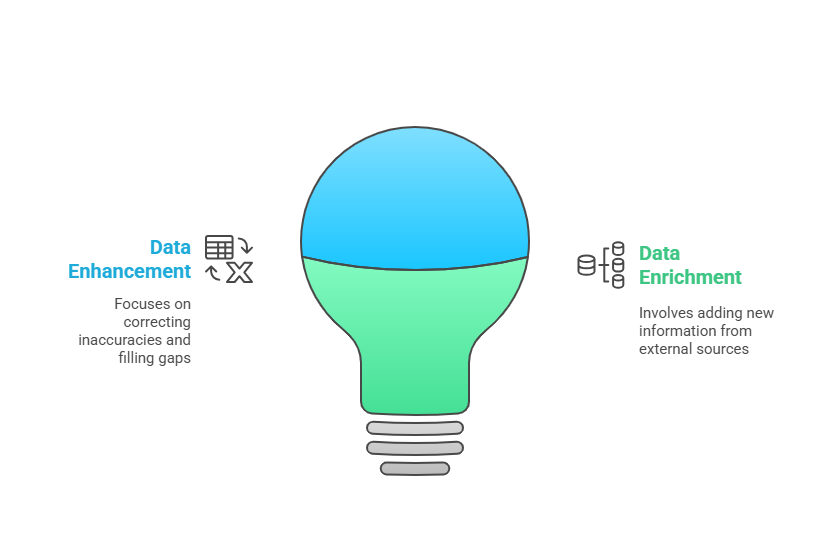Data enhancement involves improving the quality of existing data. Data enrichment, conversely, adds new data from external sources to existing datasets.
Businesses today are navigating an ocean of data that promises to unlock unique insights into their operations and customers. Data enhancement and data enrichment are two strategies they employ to increase the value of their data assets. To ensure effective decision-making, data must not only be abundant but also accurate, relevant, and actionable.
Through data enhancement, companies refine their current data to eliminate inaccuracies and redundancies, thus boosting its reliability and precision. Data enrichment service takes it a step further by augmenting the cleansed data with additional details from third-party sources, providing a more comprehensive view for analysis.
Don’t let potential customers slip through your fingers.
Take your B2B marketing to the next level with our high-quality, accurate data.
LFBBD offers B2B companies, SaaS providers, startups, e-commerce businesses, and more looking to boost engagement and drive growth through accurate and enriched datasets. Contact us .
Comparison: Data Enhancement Vs Data Enrichment
In our data-driven world, data enhancement and data enrichment are essential. Both processes aim to build stronger datasets. These improved datasets guide better decision-making. They are vital in data analysis and marketing strategies.
Yet, these two concepts are not identical. Understanding their differences marks the key to leveraging data effectively.

Defining The Concepts
Data enhancement and data enrichment involve data quality. Enhancement focuses on existing data accuracy. Enrichment involves adding external data. This broadens the dataset’s context and depth.
| Data Enhancement | Data Enrichment |
| Corrects errors | Adds new data |
| Updates old information | Brings in related data |
| Maintains data relevancy | Expands data understanding |
Importance In The Data-driven Era
- Enhanced decision-making: Improved datasets lead to better choices.
- Increased efficiency: Quality data reduces time on error correction.
- Customer insights: Enriched data reveals customer patterns.
- Competitive edge: Businesses gain advantages with superior data.
Embracing these concepts is crucial today. Enhanced and enriched data drive success. They are the backbone of a savvy data strategy.
Purpose of Data Enhancement vs Data Enrichment
| Aspect | Data Enhancement | Data Enrichment |
|---|---|---|
| Primary Objective | Fix inaccuracies, standardize, or improve usability | Add context, depth, or new attributes for better decision-making |
| Focus | Quality and integrity of existing data | Value and insight from expanded data |
| Outcome | Cleaner, more reliable dataset | Richer, more informative dataset |
Key Characteristics
Data Enhancement and Data Enrichment possess unique features that set them apart:
- Data Enhancement focuses on refining existing information within a dataset.
- Data Enrichment involves appending additional external data to the existing dataset.
These processes, when implemented, ensure that the overall database becomes more valuable for decision-making.
Differences In Objectives
The main goals of Data Enhancement and Data Enrichment are as follows:
| Data Enhancement | Data Enrichment |
| Improves accuracy of current data. | Adds new data for deeper insights. |
| Corrects errors and outdated info. | Integrates related data from multiple sources. |
| Ensures consistency within data sets. | Expands the scope of what data can reveal. |
Key Differences
| Feature | Data Enhancement | Data Enrichment |
|---|---|---|
| Source of Data | Internal (existing dataset) | External (third-party or supplementary data) |
| Scope of Change | Refines what’s already there | Expands with new information |
| Complexity | Simpler, focused on cleanup | More complex, involves integration |
| Cost | Lower (internal tools/processes) | Higher (external data often costs money) |
| Use Case | Prepares data for analysis or storage | Enhances data for insights or strategy |
| Dependency | Relies on internal data quality | Relies on external data availability |
Data Enhancement Deep Dive
The journey through data enhancement digs below the surface, where raw data evolves into valuable insights. This transformative process sharpens the edge of business strategies. It refines and corrects dataset imperfections for better decision-making. Let’s explore the essential steps and the tools that power this crucial data journey.
Steps In The Enhancement Process
Effective data enhancement follows a structured pathway:
- Evaluate current data quality to identify gaps and errors.
- Set specific goals for the enhancement efforts aligned with business objectives.
- Cleanse the data by removing inaccuracies and redundancies.
- Append missing elements by integrating additional data sources.
- Normalize datasets to ensure uniformity across the board.
- Analyze the enhanced data to generate actionable insights.
Techniques And Tools
Data enhancement relies on cutting-edge techniques and robust tools:
- Data Merging: Combining related data from different sources.
- Data Cleansing: Employing algorithms to correct or remove incorrect records.
- Data Matching: Identifying, linking, and merging related entries within a dataset.
- Data De-duplication: Eliminating duplicate entries to create a single view of the data subject.
Selection of tools depends on the requirement and volume of the data. Here are some key players in the market:
| Tool | Description | Use Case |
| Excel | Spreadsheet software for basic data sorting and cleansing. | Small datasets |
| OpenRefine | Open source tool for data cleaning and transformation. | Large datasets that require in-depth cleaning |
| Tableau Prep | Tool that prepares data for analysis. | Data visualization and prep |
| Python Libraries (e.g., Pandas) | For complex data manipulation and cleaning tasks. | Data science projects |
Data enhancement leads to the doorway of untapped opportunities. It delivers clarity, depth, and direction to the overall data strategy.
Data Enrichment Explained
Data enrichment is like giving your data a vitamin boost. It adds extra information to your current data. Imagine you have a phone book. Data enrichment is like adding email addresses, birthdays, and favorite colors next to every name.
Sources For Data Enrichment
The sources to make your data better come from many places:
- Public records: This is information that anyone can look at, like census data.
- Social media: What people share online can tell you about their likes and hobbies.
- Third-party data providers: Companies that collect and sell information that can add value to what you have.
Real-world Applications
Let’s see how data enrichment helps in the real world:
- Marketing: Businesses can know you better and show ads you might like.
- Customer service: Support teams give you a hand faster because they know more about you.
- Risk management: Banks dig into details to keep your money safe.
Achieving Accuracy And Completeness
Data enhancement and data enrichment sit at the core of business intelligence. Both processes involve improving existing data’s quality. For businesses to make smart, data-driven decisions, their data must be both accurate and complete. Achieving this blend is vital for maintaining a competitive edge in today’s fast-paced market.
Role Of Data Quality
Data quality acts as the foundation for reliable analytics. High-quality data leads to better insights and strategies. It should be accurate, complete, consistent, reliable, and up-to-date. With enhanced and enriched data, organizations can unlock the full potential of their data assets.
Overcoming Inconsistencies
To overcome inconsistencies, businesses must implement rigorous data management practices. This includes standardizing formats, cleaning data, and merging data sources. Tools and techniques used should ensure that data represents the real-world scenario accurately. Regular audits help maintain data integrity.
- Standardize data entry formats
- Use data cleaning tools to remove errors
- Merge duplicate records
- Validate data regularly
Integration In Business Intelligence
Data powers modern business strategies, and integrating enhanced or enriched data into Business Intelligence (BI) systems drives smarter decisions. Here’s how data enhancement and data enrichment play pivotal roles in leveraging BI to its full potential.
Enhancing Business Decisions
Data enhancement improves existing information quality. Business decisions benefit from cleaner, more accurate datasets. Here’s what it involves:
- Correcting inaccuracies
- Removing duplicates
- Updating outdated information
In BI, data enhancement ensures that analytics and reports reflect the current reality of the business for better strategizing.
Enriching Customer Profiles
Data enrichment builds on existing records to add depth. For customer profiles, this means:
| Current Data | Additional Enriched Data |
| Contact details | Social media activity |
| Purchase history | Buying preferences |
| Customer feedback | Demographic data |
This enriched data tailors marketing efforts and enhances customer experiences. In BI tools, richer profiles guide targeted strategies that can significantly boost conversions and loyalty.
Ethical Considerations
In the realms of Data Enhancement and Data Enrichment, ethical considerations rest at the heart of operations. These practices raise questions about how to balance the benefits of enriched data against the rights of individuals. Ethical conduct in managing data not only builds trust with customers but also ensures legal compliance. The following sections dive into the key ethical concerns.
Data Privacy Concerns
Respecting user privacy stands central to ethical data practices. Enhanced or enriched data could reveal sensitive information. This could affect someone’s life if misused. Companies need robust policies to handle data with care. This includes securing consent and protecting personal identities.
- Avoid collecting data without clear consent
- Inform individuals about data usage
- Safeguard personal data against breaches
Compliance With Regulations
Following laws and standards such as the GDPR (General Data Protection Regulation), steps towards compliance become essential. Non-compliance leads to hefty fines and erosion of customer trust.
| Regulation | Key Requirement |
| GDPR | User consent for data processing |
| CCPA | Consumer rights to data access |
| HIPAA | Protection of health information |
Businesses need to adhere to country-specific regulations alongside international standards. Regular audits prove helpful to maintain compliance.
- Conduct data protection impact assessments
- Review and update data policies regularly
- Train staff on data privacy and security
Future Of Data Processing
The world of data is evolving rapidly. Data enhancement and enrichment are pivotal in this transformation. They turn raw data into valuable insights. We are heading towards a future where data’s potential will balloon with new tech. This potential will shape how we perceive data’s role in our lives and businesses.
Emerging Technologies
Innovations are defining the future of data processing. The acceleration of machine learning and artificial intelligence (AI) can be game-changing. The capabilities of these technologies to sort, analyze, and enhance data are unprecedented. Below are technologies to keep an eye on:
- AI and Automation: Automating routine data tasks for efficiency.
- Blockchain: Ensuring data integrity and security.
- Quantum Computing: Solving complex data problems quickly.
- 5G Technology: Faster data collection and transmission.
Predictions For Enhancement And Enrichment
With emerging technologies, the scope of data enhancement and enrichment will grow. Let’s explore some predictions:
- Real-time Processing: Data will be enhanced and enriched instantly.
- Personalized Experiences: Tailored data for individual user needs.
- Privacy-focused: Stronger data protection while enriching data.
- Integrated Platforms: All-in-one solutions for data processes.
Data processing’s future looks vibrant and dynamic. It’s set to shape our world in ways we’re just beginning to understand.
Conclusion
Understanding the nuances between data enhancement and data enrichment empowers organizations to elevate their data management strategies. Each serves a unique role in refining data’s utility and relevance. Effective use of these processes ensures more informed decision-making. Embrace these tools to unlock the full potential of your business’s data landscape.






